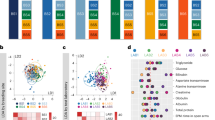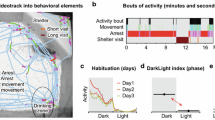Abstract
Low doses of ethanol (EtOH) stimulate activity in an open field in many strains of laboratory mice. We are selectively breeding two lines of mice to exhibit a large (FAST) response on this test, and two other lines to exhibit a small (SLOW) response (Crabbe et al. 1987). The lines initially diverged in response to EtOH, but despite continued selection pressure, the difference between each pair of FAST and SLOW lines has not increased over generations as much as expected. Our practice has been to test animals on the 1st day after saline injection, and repeat the test after EtOH injection 24 h later. Lister (1987) recently demonstrated that the order in which an animal was exposed to EtOH and saline influenced the magnitude of the response to EtOH, with animals tested initially after EtOH having greater stimulation. Middaugh et al. (1987) recently demonstrated that the magnitude of EtOH stimulation was greater under conditions of relatively bright light than under dim light. Using non-selected Swiss mice, the current experiments essentially confirmed Lister's findings. Using FAST and SLOW mice, the predictions of both groups were tested. Both hypotheses were confirmed. Additionally, these experiments demonstrated that the magnitude of the difference between FAST and SLOW mice was greater under bright light than under dim light. The line difference was also greater when tested in the EtOH-Saline order. In experiments with Swiss mice, the possible role of peritoneal irritation in the EtOH effect was eliminated, and the optimal dose and time for demonstrating the effect was determined. These experiments confirm the importance of lighting condition, order of testing, dose, and route of administration in eliciting EtOH-stimulated open field activity in mice. They demonstrate a genotype-environment interaction, since the magnitude of difference between genetically selected lines varied as a function of the testing parameters chosen. Finally, they indicate that the differences between FAST and SLOW lines in sensitivity to EtOH generalizes to several environmental conditions. We interpret this to mean that the various EtOH-induced activation traits represented by these different environmental and testing conditions are genetically correlated.
Similar content being viewed by others
References
Ahlenius S, Carlsson A, Engel J, Svensson TH, Soderstern P (1973) Antagonism of alpha methyltyrosine of the ethanol-induced stimulation and euphoria in man. Clin Pharmacol Ther 14:586–591
Ahlenius S, Brown R, Engel J, Svensson TH, Waldeck B (1974) Antagonism by nialamide of the ethanol-induced locomotor stimulation in mice. J Neural Transm 35:175–178
Buckalew L, Cartwright G (1968) General and differential behavioral effects of five ethanol dosages on the albino rat. Psychol Rep 43:1151–1154
Carlsson A, Engel J, Svensson TH (1972) Inhibition of ethanol-induced excitation in mice and rats by α-methyl-p-tyrosine. Psychopharmacologia 26:307–312
Cloninger CR (1987) Neurogenetic adaptive mechanisms in alcoholism. Science 236:410–416
Crabbe JC (1983) Sensitivity to ethanol in inbred mice: genotypic correlations among several behavioral responses. Behav Neurosci 97:280–289
Crabbe JC (1986) Genetic differences in locomotor activation in mice. Pharmacol Biochem Behav 25:289–292
Crabbe JC, Johnson N, Gray D, Kosobud A, Young ER (1982) Biphasic effects of ethanol on open-field activity: sensitivity and tolerance in C57BL/6N and DBA/2N mice. J Comp Physiol Psychol 96:440–451
Crabbe JC, McSwigan JD, Belknap JK (1985) The role of genetics in substance abuse. In: Galizio G, Maisto SA (eds) Determinants of substance abuse. Plenum, New York, pp 13–64
Crabbe JC, Young ER, Deutsch CM, Tam BR, Kosobud A (1987) Mice genetically selected for differences in open-field activity after ethanol. Pharmacol Biochem Behav 27:577–581
Falconer DS (1983) Introduction to quantitative genetics, 2nd edn. Longman, London
Frye GD, Breese GR, Mailman RB, Vogel RA, Ondrusek MG, Mueller RA (1980) An evaluation of selectivity of fenmetozole (D11–524) reversal of ethanol-induced changes in central nervous system function. Psychopharmacology 69:149–155
Holtzman SG, Schneider FH (1974) Comparison of acetaldehyde and ethanol: Depression of motor activity in mice. Life Sci 14:1243–1250
Le Blanc AE, Gibbins RJ, Kalant H (1975) Generalization of behaviorally augmented tolerance to ethanol, and its relation to physical dependence. Psychopharmacologia 44:241–246
Liljequist S, Berggren U, Engel J (1981) The effect of catecholamine receptor antagonists on ethanol-induced locomotor stimulation. J Neural Transm 50:57–67
Linakis JG, Cunningham CL (1979) Effects of concentration of ethanol injected intraperitoneally on taste aversion, body temperature and activity. Psychopharmacology 64:61–65
Lister RG (1987) The effects of repeated doses of ethanol on exploration and its habituation. Psychopharmacology 92:78–83
Masur J, Boerngen R (1980) The excitatory component of ethanol in mice: a chronic study. Pharmacol Biochem Behav 13:777–780
Masur J, Oliveira de Souza ML, Zwicker AP (1986) The excitatory effect of ethanol: absence in rats, no tolerance and increased sensitivity in mice. Pharmacol Biochem Behav 24:1225–1228
McClearn GE, Kakihana R (1981) Selective breeding for ethanol sensitivity: short-sleep and long-sleep mice. In: McClearn GE, Deitrich RA, Erwin VG (eds) Development of animal models as pharmacogenetic tools. US Government Printing Office, Washington, pp 147–159
Middaugh LD, Boggan WO, Randall CL (1987) Stimulatory effects of ethanol in C57BL/6 mice. Pharmacol Biochem Behav 27:421–424
Pohorecky LA (1977) Biphasic action of ethanol. Biobehav Rev 1:231–240
Reed TE (1977) Three hebitable responses to alcohol in a heterogeneous randomly mated mouse strain. J Stud Alcohol 38:618–632
Winer BJ (1971) Statistical principles in experimental design, 2nd edn. McGraw-Hill, New York
Author information
Authors and Affiliations
Rights and permissions
About this article
Cite this article
Crabbe, J.C., Deutsch, C.M., Tam, B.R. et al. Environmental variables differentially affect ethanol-stimulated activity in selectively bred mouse lines. Psychopharmacology 95, 103–108 (1988). https://doi.org/10.1007/BF00212776
Received:
Revised:
Issue Date:
DOI: https://doi.org/10.1007/BF00212776




